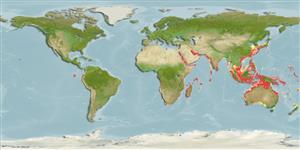>
Tetraodontiformes (Puffers and filefishes) >
Diodontidae (Porcupinefishes (burrfishes))
Etymology: Cyclichthys: Greek, kyklos = round + Greek, ichthys = fish (Ref. 45335).
More on authors: Leis & Randall.
Environment: milieu / climate zone / depth range / distribution range
Ökologie
seewasser riff-verbunden; tiefenbereich 3 - 90 m (Ref. 30573). Tropical
Indo-West Pacific: Red Sea to South Africa and east to southern Japan, the Philippines, Australia and New Caledonia (Ref. 9680). Eastern Pacific: Galapagos Islands (Ref. 5227). Mediterranean: Israel (Ref. 43448).
Size / Gewicht / Alter
Maturity: Lm ? range ? - ? cm
Max length : 34.0 cm TL Männchen/unbestimmt; (Ref. 9710)
Rückenflossenstacheln (insgesamt) : 0; Rückenflossenweichstrahlen (insgesamt) : 11 - 13; Afterflossenstacheln: 0; Afterflossenweichstrahlen: 10 - 12. Fins unspotted; adults with black spots on sides and belly, the spots associated with spine bases; no spines on caudal peduncle (Ref. 4423).
Found in coastal waters in the vicinity of reefs (Ref. 9680). Lives in seagrass habitats and coastal slopes with sponges. Active during the night (Ref. 48637). Nocturnal and solitary (Ref. 9680), usually found under ledges during the day (Ref. 9710). Juveniles pelagic (Ref. 30573). Feeds on hard-shelled invertebrates (Ref. 9680). Not usually marketed (Ref. 9680).
Life cycle and mating behavior
Maturities | Fortpflanzung | Spawnings | Egg(s) | Fecundities | Larven
Leis, J.M., 1986. Diodontidae. p. 903-907. In M.M. Smith and P.C. Heemstra (eds.) Smiths' sea fishes. Springer-Verlag, Berlin. (Ref. 4423)
IUCN Rote Liste Status (Ref. 130435)
Bedrohung für Menschen
Harmless
Nutzung durch Menschen
Fischereien: nicht kommerziell
Tools
Zusatzinformationen
Download XML
Internet Quellen
Estimates based on models
Preferred temperature (Ref.
123201): 22.1 - 29, mean 27.8 °C (based on 1622 cells).
Phylogenetic diversity index (Ref.
82804): PD
50 = 0.6250 [Uniqueness, from 0.5 = low to 2.0 = high].
Bayesian length-weight: a=0.04786 (0.01967 - 0.11644), b=2.82 (2.61 - 3.03), in cm total length, based on LWR estimates for this (Sub)family-body shape (Ref.
93245).
Trophic level (Ref.
69278): 3.5 ±0.41 se; based on food items.
Widerstandsfähigkeit (Ref.
120179): mittel, Verdopplung der Population dauert 1,4 - 4,4 Jahre. (Preliminary K or Fecundity.).
Fishing Vulnerability (Ref.
59153): Low vulnerability (24 of 100).
Nutrients (Ref.
124155): Calcium = 41.9 [18.0, 102.3] mg/100g; Iron = 0.616 [0.314, 1.379] mg/100g; Protein = 18.3 [16.1, 20.5] %; Omega3 = 0.12 [0.06, 0.23] g/100g; Selenium = 42.6 [21.9, 87.4] μg/100g; VitaminA = 48 [14, 172] μg/100g; Zinc = 1.05 [0.72, 1.56] mg/100g (wet weight);
